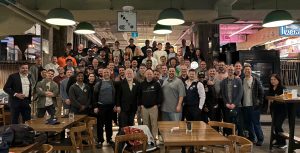In the Chia in China Year of the Dragon AMA with Bram and Gene, Bram alluded to research into a new plot format as a means to ensure plot grinding will not be a viable way to farm Chia. This was reiterated again a couple days ago on Discord and more insight was provided.

The Discord was subsequently filled with many parallel conversations with opinions and questions about implications and implementation details. There is also bound to be differing interpretations as to what this means, but let’s cover the facts.
The primary motivation for a plot format change is to address the risk of plot grinding.
What is plot grinding and why is it a problem?
Plot grinding is the ability to create a proof of space in response to a challenge without storing any part of a plot. In other words it allows for a lot of GPU compute power to farm Chia without using any storage. It can also be thought of as using compute to simulate storage space.
Plot grinding has technically been possible for a while now but it has been far from economical. What has changed recently is the advent of AI and the accelerated push for faster GPUs with higher VRAM and memory bandwidth that brings economical plot grinding timelines too close for comfort.
Economical plot grinding is not a first order security problem unto itself. The entire network could run as “Proof of Work” and it would function just the same. However, there are two issues with this:
- The perception of Chia as a green chain is what ensures a sticky and high security budget in the form of latent storage space securing the chain. A problem we’ve seen in the past with less popular Proof of Work networks is the fungibility of GPU compute (hashrate) means a huge portion of it can abandon a chain on a whim, leaving it vulnerable to attacks.
- Exposure to rental attacks becomes a real risk to the chain. There are numerous chains that use the same hashing algorithm as Bitcoin and with centralized pooling and services like NiceHash, these chains are a single person’s decision away from being 51% attacked with rented/coerced hashrate diverted from Bitcoin. With the current hype of AI, it’s not hard to imagine a future time when demand for GPU compute wanes and the ability to rent a ton of idle GPUs to carry out a 51% plot grinding attack on the Chia blockchain is within the realm of possibility.
How does this relate to plot compression?
Plot compression is a separate but related issue to plot grinding. The technology that enables faster plotting, plot compression, and plot grinding are the same: optimized use of GPUs to create a plot (or part of a plot).
The advent of proprietary “compressed” plot formats from third parties such as Gigahorse, NoSSD, and most recently DrPlotter has led to the following objective facts due to different implementation choices from these vendors:
- Plotting has become much faster and more energy efficient.
- On average, farming has become more energy intensive but more energy efficient per effective space.
- Due to the above, the overall power footprint of the entire Chia Network has not drastically changed. (Source: Chiapower Energy Model 2023)
- Effective netspace has increased but it is not clear that the amount of raw storage securing the chain has increased. That is, security budget is not obviously higher.
- Nakamoto Coefficient has decreased dramatically due to NoSSD centralized pooling that does not follow the official pooling protocol.


It has also led to some subjective sentiments about the network, namely that:
- Chia is becoming closer to Proof of Work
- Home farmers can not compete with professional farms
- Barrier of entry to farming has increased
It’s important to keep in mind that all of the plotting developments from OG plots to NFT pool plots to Gigahorse, Bladebit, NoSSD to NoSSDv2, Gigahorse v2.5, and DrPlotter have been entirely optional. OG plots in some farm configurations could still make the most sense. The options and supported hardware configurations to plot and farm Chia has only increased over time.
A new plot format would mark the first change that would actually be mandatory for farmers to adopt if they wish to continue participating in consensus.
So what problems are we trying to solve with a new plot format?
Although the primary motivation may be to preserve the security of the network by eliminating plot grinding, it is clear that there are other considerations going into the design of a new plot format. A plot format hard fork could accomplish the following:
- Make plot grinding much more difficult
- Maintain the ability to create plots quickly
- Reduce the operational costs of farming
- Greatly reduce (but not eliminate) the effectiveness of plot compression
- Have the most efficient farming to be heavily storage based rather than a mix of storage and compute
- Recover Nakamoto Coefficient through any new vendor implementation adopting CHIP-0022
- Maintain network security budget throughout the transition to a new plot format
- Level the playing field and instill a belief of “fairness” with farmers.

Why should existing plot vendors support a new plot format?
There could be a few reasons existing plot vendors support this hard fork even though it directly contradicts their existing business model of selling compressed plot technology.
- With the CHIP-0012 plot filter reduction schedule hard fork adopted by the network, plot vendors have known that their business model has limited runway even without a plot format change.
- There will always be some level of compression available with any plot format. The goal is to ensure the exponential trade off between space and compute starts off much higher but it doesn’t preclude a talented developer from offering a plotting and farming software with enough of a value proposition to entice farmers to use it. And with CHIP-0022 implemented, the means to provide a closed source implementation while maintaining decentralization of the chain will become an expectation of the community.
- The decentralization of the chain is a core characteristic of Chia so it would also be in plot vendors’ interest to see higher netspace, higher security budget, increased decentralization, and hopefully a higher XCH price as a result.
- But ultimately it is the farmers that choose. If the farmers vote with their storage and opt for a new plot format, the vendors will be motivated to follow the main chain upon which vast majority of development and adoption will continue.
What are other solutions?
In terms of grind resistant plot formats, there is the one Max is using for his MMX blockchain that removes the need for a plot filter.
There are other levers that can also be utilized to make plot grinding harder though these don’t address the other issues mentioned above.
For example a more aggressive plot filter reduction schedule pushes out the timelines for economical plot grinding. Other breaking consensus changes can also be considered such reducing signage point intervals but only indirectly address the problem.
What are the timelines for a plot format?
There are several milestones for such a hard fork to be adopted:
- CHIP published with the details of a proposed hard fork. Discussions and iterations ensue.
- Gain enough community support on the CHIP and adoption of updated node software with the hard fork logic.
- First fork date: New plot format becomes eligible for farming alongside old plot format.
- Second fork date: Old plot format no longer eligible for farming.

How long could I continue farming my existing plots?
If I had to estimate the timelines for each of these milestones, I would conservatively guess:
- (3-6 months): CHIP published and discussions ensue to reach an implementable plan.
- (6 months): Software released with hard fork logic implemented, farmers given 6 months to upgrade.
- (12 months): Both formats eligible for farming, farmers start plotting towards new format.
- Only new format is eligible for farming. Hard fork complete.
My conservative estimate for time until current plots can no longer be farmed: ~2.5-3 years
What are other considerations?
In no particular order, here are a number of other open questions that may get flushed out in the coming months:
- How will community buy-in be measured?
- How will farmers be incentivized to replot to the new plot format? Will new plots be counted as higher effective netspace than old plots?
- Will we have a k-size increase along with the new format? If not immediately then perhaps proactively in the future?
- Could we bring the plot filter back to 512 if grinding is addressed by other means?
- What other features could we hard fork in at the same time?
- Will the new plot format be plotted without a GPU? (indication is no)
- Upon a hard fork, what will determine which fork is valid? Amount of netspace on each? CNI declaration? CEX exchanges decision on which keeps the XCH ticker?
- What will the forked chain be called? What will happen to the prefarm on that chain?
Will this new plot format hard fork actually happen?
Although specifics on implementation timelines or even technical details could be up for debate and iteration, it is clear there is a desire from Chia Network and many farmers to see such an update.

However, CNI (and Bram specifically) have proposed ideas in the past that have been shot down by the community. CHIP-0003 introducing minimum transaction fees come to mind. So I would not consider this new plot format a sure thing but my guess is some form of this proposal will be implemented.
What do you think?










[…] article “New Chia Plot Format – Explained and Demystified” […]
The plot format change WILL happen – it’s already being worked on by report.
I would NOT anticipate it being in a 3 year timeframe before mandatory, more likely 1-2 years guesstimate, with a 3-6 month transition period where both are usable.
On the other hand, CMI is suffering from small staff issues the last few months, it MIGHT take longer.